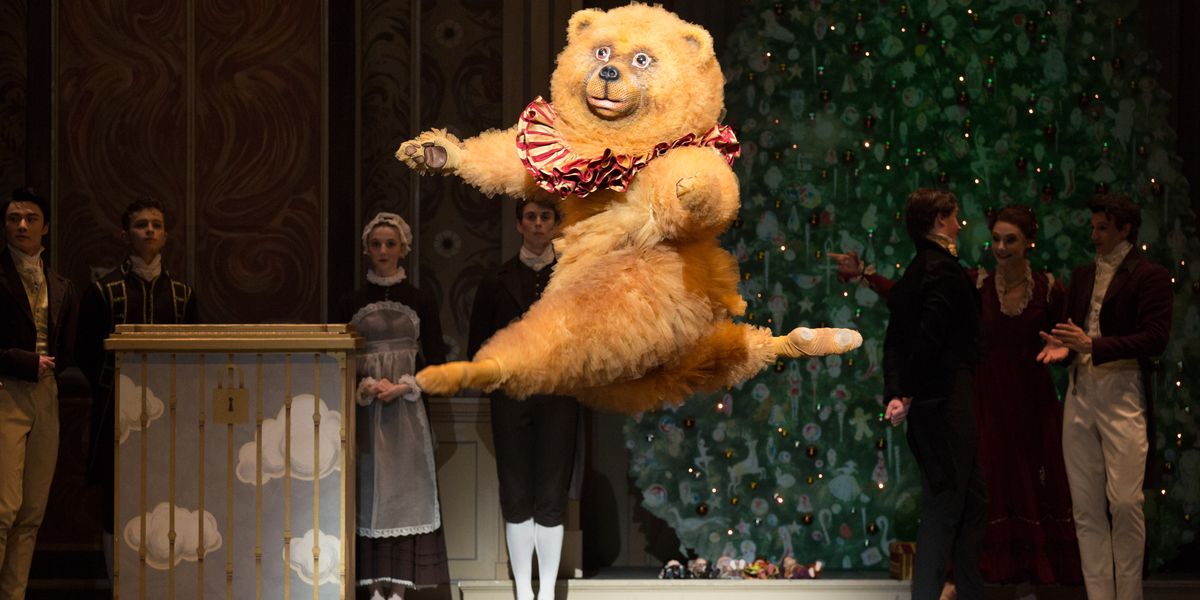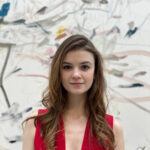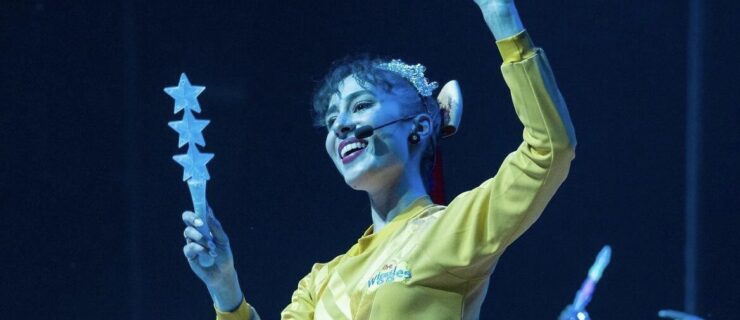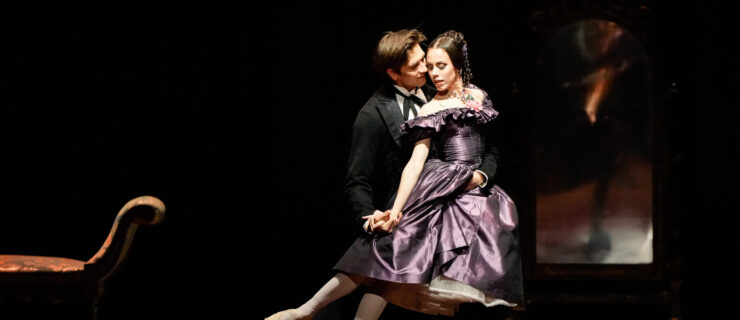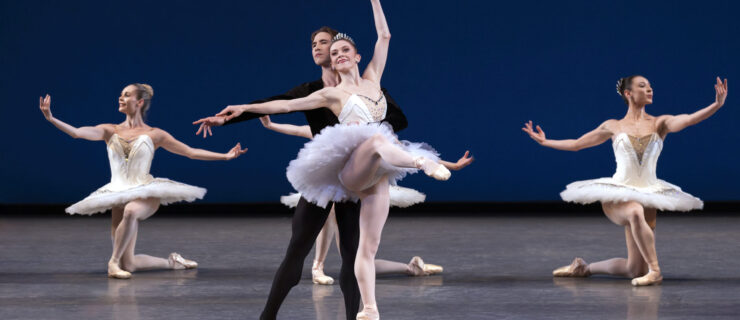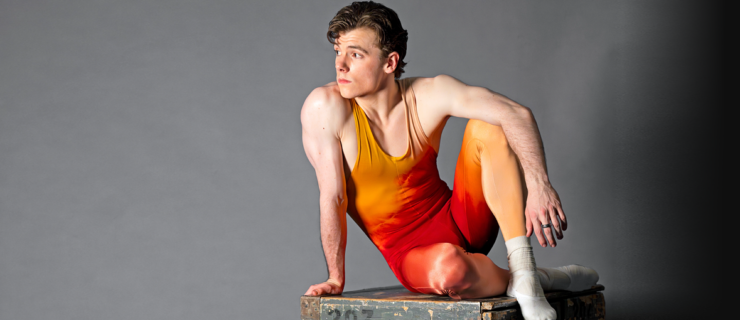Mastering the Magic: 5 Dancers On How They Manage The Nutcracker's More Cumbersome Props and Costumes
For dancers, The Nutcracker isn’t all winter wonderlands and charming sweets. To bring this ballet to life, we have to spar with swords (often while wearing a clunky head), pirouette in animal suits, and perform day after day with a host of other potentially hazardous costumes and props. Despite the dangers, Nutcracker‘s eccentric roles can be the most fun to perform. As five dancers describe, Nutcracker‘s whimsical, albeit taxing, accoutrements have their own kind of magic.
Party Scene Bear: Daniel Durrett, Boston Ballet

Samuel Zaldivar in Boston Ballet’s “Nutcracker.” Photo by Rosalie O’Connor, Courtesy Boston Ballet.
Boston Ballet’s fluffy, dancing bear is a veritable celebrity around Beantown during Nutcracker season. In addition to busting out in the ballet’s party scene, he shows up on social media to announce ticket sales and performs around the city for special events. As corps member Daniel Durrett has learned, however, that lovable bear head is not exactly light and fuzzy, and the variation—with plenty of turns and traveling jumps—is anything but simple. Durrett recalls, “There was one show when the head strap broke mid-jump and thankfully it was towards the end of the solo, because I couldn’t see anything.” The head shifted around particularly while spotting, but he managed to finish without taking out any party children.
Durrett prepares for shows by giving himself a barre, putting the bear suit on early and running the solo twice to get used to the head and moving in the costume. Despite some minor neck soreness after his first few times, Durrett says, “I absolutely love performing as the bear. It’s such an honor to get to perform such a crowd-pleasing role.”
Mouse King: Adam Hartley, Oregon Ballet Theatre

OBT’s Mouse King (portrayed here by principal Peter Franc) has six heads. Photo by James McGrew, Courtesy OBT.
In Oregon Ballet Theatre’s Balanchine Nutcracker production, dancers like company artist Adam Hartley have to wear a six-headed Mouse King suit. And it’s quite the contraption. “The first part you have to put on has all the smaller heads,” says Hartley. “It’s like a big harness to attach to your torso. It feels like what I imagine a parachute would be like with a bunch of straps and connections. And then you have to put on the mouse suit, which is basically a giant piece of fur stuffed with tulle.” The main head has two little eye screens to see out of. He dons this last, waiting as long as possible before “sealing in the heat.”
Hartley describes the costume as that of a sporting mascot’s, with a neck brace: lots of volume with little airflow, peripheral vision, mobility or even hearing. Despite everything working against him, he says, dancing the Mouse King role is an opportunity to hone his dramatic acting skills. “I can come out of my shell a little more and do things that I normally would be too embarrassed to do.”
Mother Buffoon: Trevor Naumann, Ballet West

Trevor Naumann as Mother Buffoon. Photo by Beau Pearson, Courtesy Ballet West.
For the two dancers that make up the Mother Buffoon role in Ballet West’s Nutcracker, the perils are many. The bottom man (the legs) wears protective gloves to push the massive, wheeled steel dress frame around the stage, which he can barely see through the overlaying tulle. The top man stands on a tall, horseshoe-shaped platform with only his upper body exposed. He wears the makeup and wig, waves the fan and has to pull quite a few strings—literally. “I’ve had all sorts of incidences where I’m trying to fan myself and grab the dress rope, and then that rope gets caught on the fan rope,” jokes demi-soloist Trevor Naumann.
Complicating matters are the eight small children dressed like bees who emerge from the dress. There’s no shortage of chatter under there, Naumann explains, and sometimes their tiny hands dart out to pinch and tickle both company dancers’ legs. Distractions or not, he says, “I love doing that part. You get done early, people love you—it’s fabulous.” However, he stresses, it’s buffoonery with restraint: “You can get in quite a bit of trouble if the jokes become vulgar or out of character. Our boss always says to remember, you’re a mother.”
Nutcracker Doll: Rob Morrow, Louisville Ballet

After sweating through the battle scene in the Nutcracker head, Morrow transforms into the Prince. Photo by Sam English, Courtesy Louisville Ballet.
As the ballet’s namesake, the Nutcracker doll is somewhat crucial to the proceedings. In Louisville Ballet’s production, says company member Rob Morrow, the Nutcracker does the party scene and battle scene, then goes straight into dancing the snow pas de deux with Marie. He essentially has to wear two costumes: the doll tunic with toy-appropriate buttons, and the princely layer underneath. When the outer layer and head come off, Morrow says, he’s not just worried about stamina for the next scene: “I have all this gel in my hair, trying to look princely before the show, and then I have a helmet pushing it down. So after I take it off I’m like, ‘Is my hair okay?’ ”
Wearing the head isn’t all bad. In the party scene, Morrow says, “you kind of get a moment to get your stage legs without really being seen.” But thick suits and poor visibility might result in a missed cue. At one point during the battle scene, the Nutcracker is supposed to kill a rat after landing from a double saut de basque—yet with limited visibility, Morrow sometimes swipes air with his sword instead of fur. When this happens, he says, Marie steps in to help. She whispers to the rat, “Go!” or “Die!” Nutcracker: a team effort.
Mirliton: Elizabeth Powell, San Francisco Ballet

Kimberly Marie Olivier twirls the seven-foot ribbon. Photo by Erik Tomasson, Courtesy SFB.
In San Francisco Ballet’s production, the Act II Mirlitons are three colorful cancan girls complete with garter belts, bright teal tights and pointe shoes. Tall hair feathers and seven-foot handheld ribbons (for flicking and twirling) complete the costume, and these latter two items can hinder an already difficult dance. “We do a double attitude turn, and at the very end of it, you have to whip the ribbon up a little bit more so it comes completely around again,” says soloist Elizabeth Powell. “Sometimes I’ll feel it go around my wrist or kind of swipe my feather.”
Even though dancers start working with the ribbons on the first day of rehearsals, Powell has seen and experienced a host of onstage mishaps in her eight years of dancing the role. Once, her ribbon got completely tied up with another dancer’s, and no amount of creative flicking could disentangle the knot. They made a snap decision to toss the props offstage rather than muddle through the choreography. Powell’s best advice for stress-inducing props is to keep things in perspective: “If something crazy does happen, it’s live theater. It wouldn’t be the first time and it won’t be the last.”
